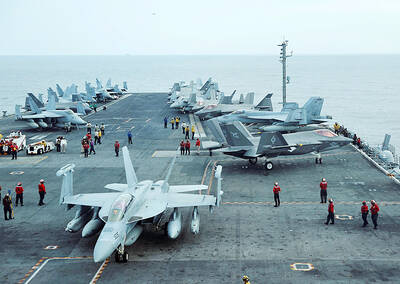Chinese fishermen have been accused of poaching in Taiwan’s first marine national park, where authorities say their destructive methods are endangering the area’s ecology.
“Chinese fishing boats have been posing the gravest threat to the fragile ecological system here,” said Shaw I-pung (蕭一鵬) of the Marine National Park headquarters, speaking of the tiny coral atoll called Dongsha Island.
“They have been using illegal methods like poisons, dynamite and electricity to exploit marine resources in the region,” he said.

PHOTO: AFP
The scourge of boats scouring the seabed for food destined for Hong Kong restaurants is combining with global warming as a major cause of coral reef bleaching, he said.
The Dongsha Islands, comprising Dongsha Island and two coral reefs which are submerged at high tide, straddles a strategically important sea route at the north of the South China Sea linking the Pacific and Indian oceans.
The island is a coral atoll with a land area of 2.4km². It measures 0.9km from east to west, and 2.7km from north to south.
Shaw said the unquenched appetite for Hong Kong’s famed Cantonese seafood is to blame.
“Most of the marine catches here, like fishes and lobsters, are quickly sent to Hong Kong, which touts itself as the world’s biggest living fish market,” he said.
Chinese fishermen, plus some Vietnamese, use cyanide to stun fish and catch them live for higher commercial prices, he said.
“Cabrilla can be sold for US$30 per kilo in Hong Kong and some other fish even sell for up to US$100 per kilo,” Shaw said.
Dongsha is 267km away from Hong Kong and 380km from Kaohsiung City.
“Smaller fish and corals were destroyed by the poisons, largely cyanide, which is easily available in China,” Shaw said.
However, “the destructive way of fishing has been endangering the coral reefs near Dongsha,” which Shaw described as an “ocean rain forest” and a biodiversity hot spot.
Academics found there are 264 species of coral, 556 species of fish and 140 species of bird — many of them migratory — in that area.
Taiwan’s coast guard says it has stopped 3,820 ships infiltrating the prohibited Dongsha waters since they were deployed in 2000.
Taiwan withdrew its Marines from Dongsha in 2000 in what the government said was a move to help alleviate tensions in the South China Sea.
Currently there are around 200 coast guard personnel are stationed on Dongsha and armed with a fleet of six patrol boats — three 10-tonne vessels and three other eight-tonne boats. There are no civilian inhabitants.
But the fleet is apparently not strong enough to serve as a “deterrent” to the Chinese and Vietnamese invaders.
“They often come back after we leave,” a coast guard officer said on condition of anonymity.
The government is now building the first permanent pier on the island to house the three incoming 20-tonne boats.
“Bigger ships would help us battle invaders as they increase our cruising capability,” said Liu Kuo-lieh (劉國列), the Dongsha coast guard commander.
As part of its ocean conservation efforts, the government inaugurated the Dongsha Marine National Park in January last year. The park administration is centered on the monitoring and conservation of the local ecology.

A year-long renovation of Taipei’s Bangka Park (艋舺公園) began yesterday, as city workers fenced off the site and cleared out belongings left by homeless residents who had been living there. Despite protests from displaced residents, a city official defended the government’s relocation efforts, saying transitional housing has been offered. The renovation of the park in Taipei’s Wanhua District (萬華), near Longshan Temple (龍山寺), began at 9am yesterday, as about 20 homeless people packed their belongings and left after being asked to move by city personnel. Among them was a 90-year-old woman surnamed Wang (王), who last week said that she had no plans

TO BE APPEALED: The environment ministry said coal reduction goals had to be reached within two months, which was against the principle of legitimate expectation The Taipei High Administrative Court on Thursday ruled in favor of the Taichung Environmental Protection Bureau in its administrative litigation against the Ministry of Environment for the rescission of a NT$18 million fine (US$609,570) imposed by the bureau on the Taichung Power Plant in 2019 for alleged excess coal power generation. The bureau in November 2019 revised what it said was a “slip of the pen” in the text of the operating permit granted to the plant — which is run by Taiwan Power Co (Taipower) — in October 2017. The permit originally read: “reduce coal use by 40 percent from Jan.

China might accelerate its strategic actions toward Taiwan, the South China Sea and across the first island chain, after the US officially entered a military conflict with Iran, as Beijing would perceive Washington as incapable of fighting a two-front war, a military expert said yesterday. The US’ ongoing conflict with Iran is not merely an act of retaliation or a “delaying tactic,” but a strategic military campaign aimed at dismantling Tehran’s nuclear capabilities and reshaping the regional order in the Middle East, said National Defense University distinguished adjunct lecturer Holmes Liao (廖宏祥), former McDonnell Douglas Aerospace representative in Taiwan. If

‘SPEY’ REACTION: Beijing said its Eastern Theater Command ‘organized troops to monitor and guard the entire process’ of a Taiwan Strait transit China sent 74 warplanes toward Taiwan between late Thursday and early yesterday, 61 of which crossed the median line in the Taiwan Strait. It was not clear why so many planes were scrambled, said the Ministry of National Defense, which tabulated the flights. The aircraft were sent in two separate tranches, the ministry said. The Ministry of Foreign Affairs on Thursday “confirmed and welcomed” a transit by the British Royal Navy’s HMS Spey, a River-class offshore patrol vessel, through the Taiwan Strait a day earlier. The ship’s transit “once again [reaffirmed the Strait’s] status as international waters,” the foreign ministry said. “Such transits by